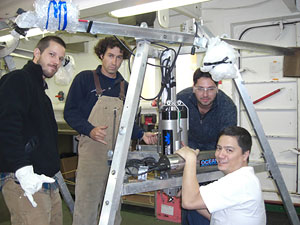

 | |||||||||||
|
|
Journals 2008/2009Roy Arezzo
July 12, 2008 A slow morning is always welcome. We are still transiting south and there is some down time between prep work. There are certain amenities aboard to make ship life more at home. In addition to the gym and the galley there is nice lounge on the second deck with a library of videos, cushy recliners, acoustic guitars and board games. The conference room on the third deck has a comfortable workspace, lots of books, and computer stations. Our cabins are small but cozy. The bridge has magnificent 360-degree views and is and a welcoming crew. For the ballers in town there is the "helo hanger" which in addition to a basketball rim is equipped with a foosball table next to the chemical storage container. The only thing not stored in the helo hanger is the helicopter since we do not have one aboard. It turns out that any game involving a round ball is generally a bad idea on a moving boat. This does not stop the science team of the NBP. Any chance to get physical with a round ball is met with gusto and tonight the PHD team of Paulo and Craig ate up competition for over 10 matches until Roy and Dan (UH coral reef guy) put a stop to their winning streak with a few close wins. I have been going out on deck each day for air. As we extend deeper into the Drake Passage the seas have risen. There is much snow, ice and wind out there now and we are not permitted on decks without checking in with the bridge first.
We are fortunate to have an international crew aboard the NBP. There are scientists from the U.S, U.K, Croatia and Brazil all bringing a wealth of experience to the project. Today I tagged along with team Brazil for a little chemistry. We mixed stock solutions to prepare for experiments aimed at assessing the biomass of organisms we recover from the sea floor. We mostly created alkaline buffers and diluted acids to be used for critter ATP analysis; one way of measuring the total amount of organisms housed in the muddy bottom. The scientists from Brazil come to us by way of the Oceanographic Institute at the University of Sao Paulo. Dr. Paulo Sumida worked on the first FOODBANCS Project in 1999 - 2001 with Dr. Craig Smith. Paulo grew up in Sao Paulo, Brazil, where despite being landlocked 80 kilometers from the coast he dreamed of joining Jacques Cousteau missions to the deep sea. He studied biology in a local university and was granted a scholarship to study marine science abroad at the University of Southampton in England. His advisor, Paul Tyler, a friend of Craig Smith, introduced the two of them at a conference. When Paulo had finished his degree he was invited to University of Hawaii (UH) to do his post-doctorate work on the FOODBANCS Project with Craig Smith. He is a now a professor back in Sao Paulo where his research focuses on deepsea science. His lab continues to collaborate with the research out of Hawaii and some of his students work at both sites. Arthur Guth has his Master's of Science in biology and works in Paulo's lab as a biology technician. In addition to being my cabin mate, he has a great love of marine science. Back in Brazil where he lives with his family he enjoys photography and SCUBA diving. Arthur has a brilliant camera and has been very generous in sharing his photos. He is helping out with trawls and dissections this cruise and looks forward to studying new organisms since this is first time in Antarctic waters. Angelo Bernardino is a doctorate student in Paulo's lab back in Brazil but is currently working at UH as a visiting research scholar on the FOODBANCS2 project through a joint collaboration between the two universities. Angelo has always been interested in diving and spent a lot of time by the water back in Brazil. He became familiar with FOODBANCS when he was permitted to use the images from the first project of the sea floor for his master's degree thesis. Although his current research is mostly focused on comparing benthic communities of various nutrient inputs, such as sunken wood, kelp and whale falls, his expertise in underwater photography has him leading the team on the timelapse camera system. Fabio DeLeo, our blog master, is a graduate student who earned a master's degree in biological oceanography at the University of Sao Paulo where he also became familiar with Craig Smith's work through Paulo. He grew up spending time on the water with his family and he has a strong interest in fish populations and fisheries science. His thesis work is in benthic communities found in submarine canyons in waters off the continental shelves of New Zealand, Hawaii and California. These canyons range in depth form 300 to 1500 meters and he hypothesizes that in many benthic systems, coastal nutrient inputs to these canyons supply much of the nutrition for fisheries important to humans for food. Fabio will be called upon on many tasks throughout the cruise and he currently is working with Angelo to get the camera ready for the depths.
Today the tech team aboard assisted me with downloading some of the video footage I shot of our crew preparing for the voyage. Unfortunately, I am having trouble figuring out their software so anyone familiar with Final Cut software who happens to be around 63° S drop in and give me a hand. |
||||||||||

